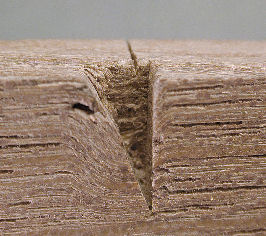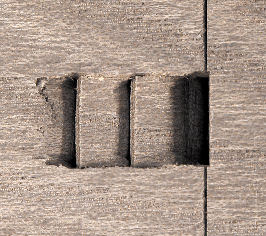

Chopping up to a line…
I've been driving a 1/2in bevelled edge firmer chisel into a piece of an Elm look-alike (Japanese Sen, Kalopanax.spp). The idea was to replicate a basic woodworking task - chopping out waste.
Chopping is one of the hard-pressed tradesman's ways of removing wood from between the pins of a set of dovetails.
Yes, there are other very valid ways of doing the job! Please see:Dovetailing Detailed

Firstly, I photographed the result of a single chop where the chisel was placed directly in the incision made by a marking knife. As it was driven, the sharp edge severed the wood fibres. These were then forced downwards and backwards by the bevel until the wood was so compressed that the chisel became wedged firmly into place.
Note the distortion of the fibres revealed in the pic.
During the downward progress, the wedging action eventually moved the chisel face rightwards and well beyond its starting place, compressing and bending the fibres in its path. An engineer might say that the reaction of the fibres against the bevel is the cause of the displacement. This measured about 0.52mm (21 thou).
If a cut is then made to the right of the one above, the fibres severed by the edge should then be easily sheared backwards by the action of the bevel. The chisel can then drive straight downwards without being pushed forwards.




An Inevitable Cavity. When you complete the operation by chopping from the opposite face, the inevitable result is the sudden fracture of the last few fibres leaving a cavity in the end grain of the job. End grain does not take glue very well at all, so for some classes of work the loss of gluing area does not matter. SeeAdvice for Choppers.
Sometimes one has to take care that a cavity is not revealed when for example, producing a test piece for an examiner, or by operations such as sawing a box apart to form a lid, or perhaps planing its sides for some decorative purpose.
For alternatives, please see other areas ofDovetailing Detailed.


In soft or thin material you could actually get away with a minimum of two cuts, but take heed of this pic, the outcome of a bit of simulated carelessness. The first cut established the essential void, but the chisel moved slightly downwards so the pressure of solid wood behind the half of the bevel uncontrollably rotated the edge, so forcing a wonky cut.